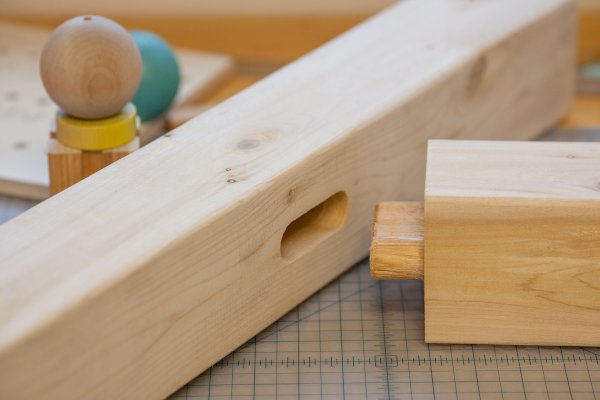Catalog Mailing Address
Planning for your playset: what's holding it together?
Expert Advice | 5 years ago

People who are playset shopping have a lot of things to consider when choosing the right set for their family: price, size, what it’s made of, how many swings it has, or even how it will look in the backyard. But most people don’t think about one of the most important things: how the playset is put together. The construction methods used to put a playset together are key to the playset's strength and safety.
There are many different ways to construct a wooden playset, and there are combinations of fasteners and joinery that are better than others for the various components of a playset. The following is an overview of what you might find and where and how it is best used.
FASTENERS
By fasteners, we mean the hardware - nails, screws, or bolts - used to hold parts of the swing set together.
Nails: Nails provide the weakest connection and should not be used where the structural integrity of the playset could be in question as they have a tendency to loosen and come out over time. Certain types of nails, however, such as ring nails, or nails in combination with wood glue, can be well-suited for holding together components that are not subject to major stresses. At CedarWorks, we rarely use nails, and would never use them for anything weight-bearing or where the structural integrity of the playset would be in question
Wood screws: Small-dimension wood screws resist backing out significantly better than nails, but they are not strong enough to be safely used in structural joints. Wood screws can be well-suited for connecting non-load bearing elements and can create a very strong joint when used in conjunction with wood glue. Again, we wouldn’t use wood screws for anything load-bearing.
Lag screws: These are larger diameter screws that typically have a hexagonal head and are installed with a socket wrench. Due to their size, they are stronger and have significantly more "bite" than wood screws. Lag screws are frequently used to hold larger dimension wood in a more structural capacity.
Bolts: Bolts in conjunction with a nut are the most secure of the fasteners. Bolts pass completely through the wood and are not subject to loosening and backing out in the same manner as screws. Of course, the dimension and material of the bolt along with the "locking" capacity of the nut can vary significantly, so not all bolt construction is as secure as others. However, bolt construction is preferred where structural integrity of a joint is essential.
JOINERY
Playsets have lots and lots of joints (the place where two pieces of wood come together) and some joints are more critical for a safe and long-lasting playset than others. Similarly, some methods used to create the joint (joinery) are safer and longer-lasting than others. Listed below are the most typical forms of joinery you will find on a playset.
Butt joint: This is where two pieces of wood come together in line with each other and without any overlap. When only fasteners are employed to hold the wood together, this is the weakest type of joinery used in playsets and is only suitable for decorative elements.
Lap joint: A lap joint is where two pieces of wood overlap each other and are held together with fasteners. This is the most common form of joinery used in playsets. The strength of the joint depends on many factors such as the dimensions of the wood and type of fastener used. In general, small dimension wood held with nails or wood screws is not suitable for load-bearing elements while larger dimension wood with lag screws or bolts can successfully support very large loads
Mortise and Tenon: Mortise and tenon is considered the strongest and most aesthetically pleasing type of joinery used in playsets. A mortise is a pocket carved into one of the pieces of wood being used to form the joint. A tenon is typically a narrowed portion at the end of the other piece of wood that will form the joint. The tenon of one piece is inserted into the mortise of the other and then the tenon is secured into place with a fastener. In this type of construction the fastener does not bear any weight but rather serves to keep the tenon from pulling out. Mortise and tenon can be used for any type of joint including all structural joints. At CedarWorks, mortise and tenon is our favorite type of joinery because it is so strong.
BRACING
All of the types of joints listed above can be significantly improved with the addition of brackets and braces. These items can be made of metal or wood and can be attached with the full range of fasteners.
Face mounted brackets are installed with fasteners alongside the outside of the joint and indirectly support the weight of the joint; the fasteners directly support the weight. In-line braces are even more supportive and are installed inside the joint instead of alongside the joint. Though held in place with fasteners, the braces themselves directly support the weight of the joint.
IN A NUTSHELL
Every playset on the market will have some combination of fasteners and joinery. The less well constructed playsets will feature small dimension screws, butt and lap joints, and face mounted brackets while the best constructed playsets will feature bolts, mortise and tenon joints, and in-line weight bearing braces. The better-constructed playsets will be stronger and safer, and they will last longer, so make sure while you research playsets that you check out how it's put together .
For more on what to look for in a playset, visit Swing Sets 101.
#family#outdoor
#safety
#swing-set
